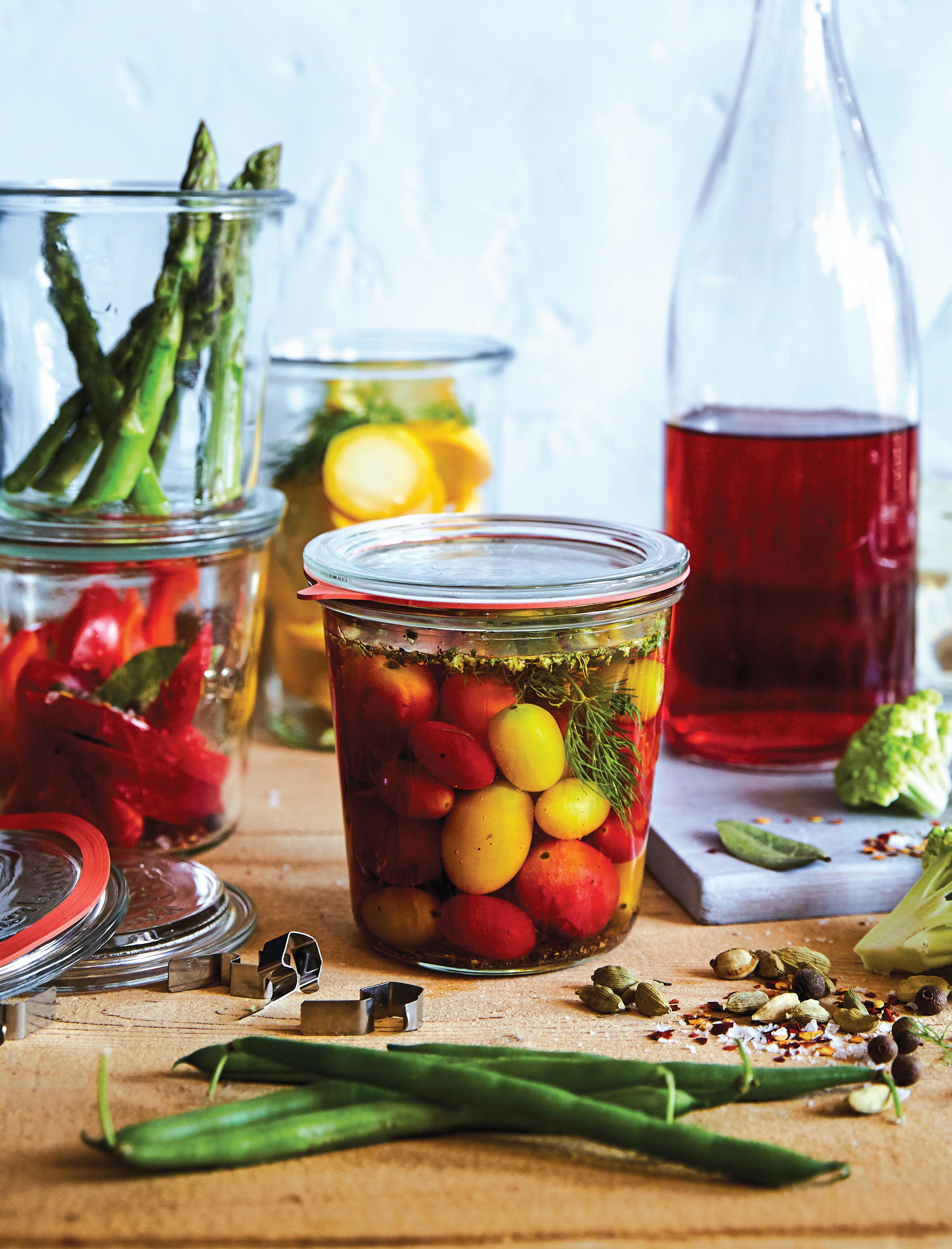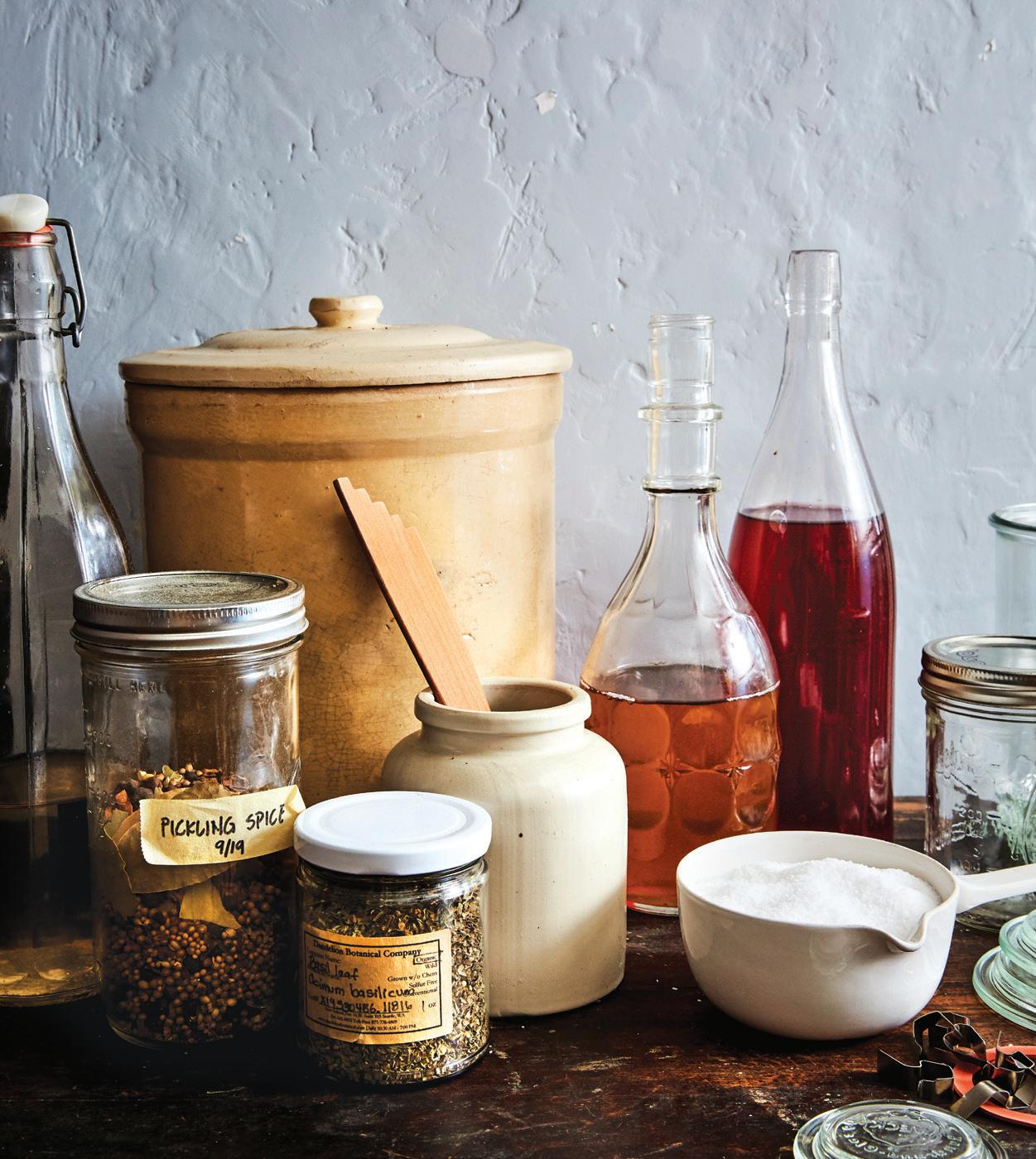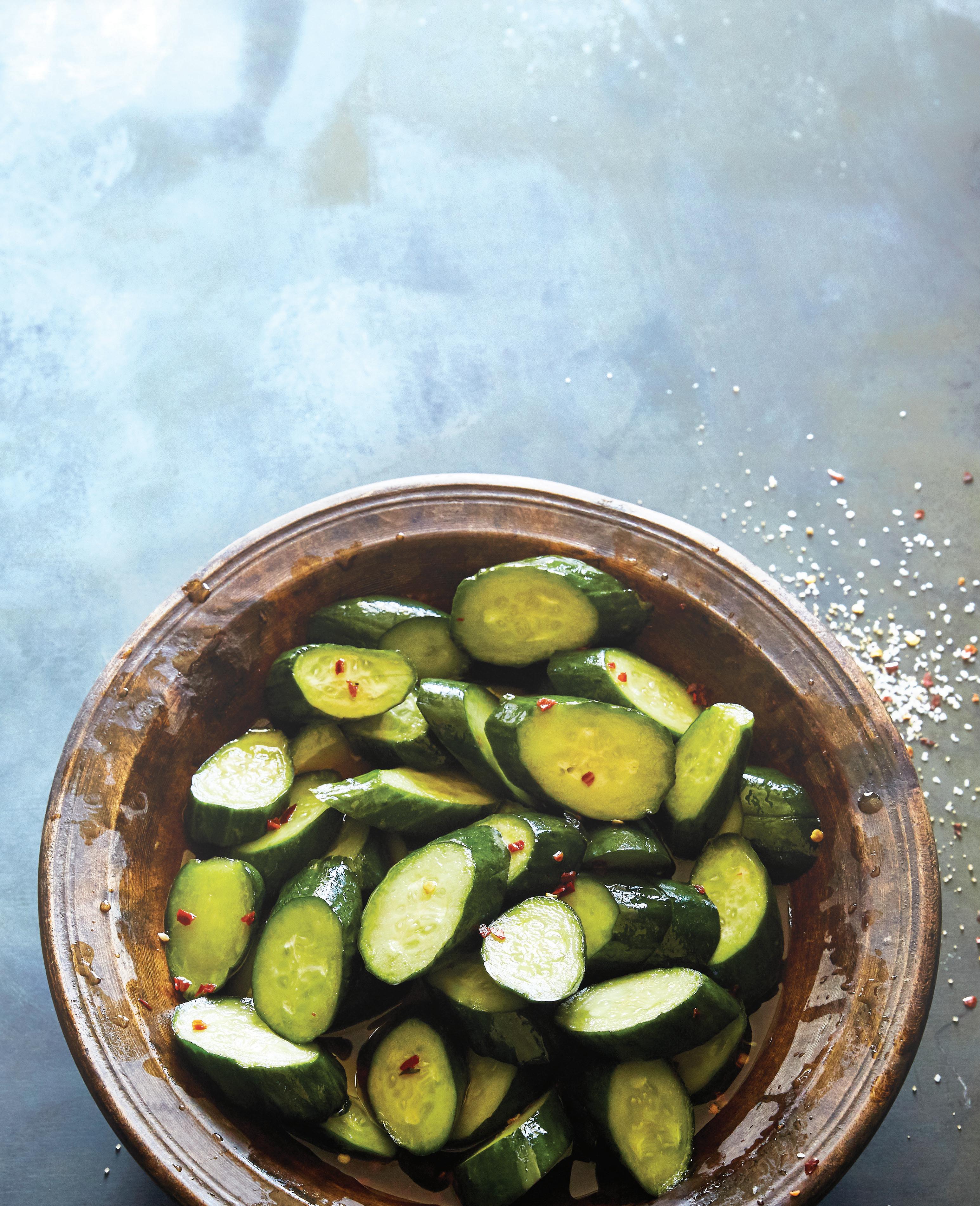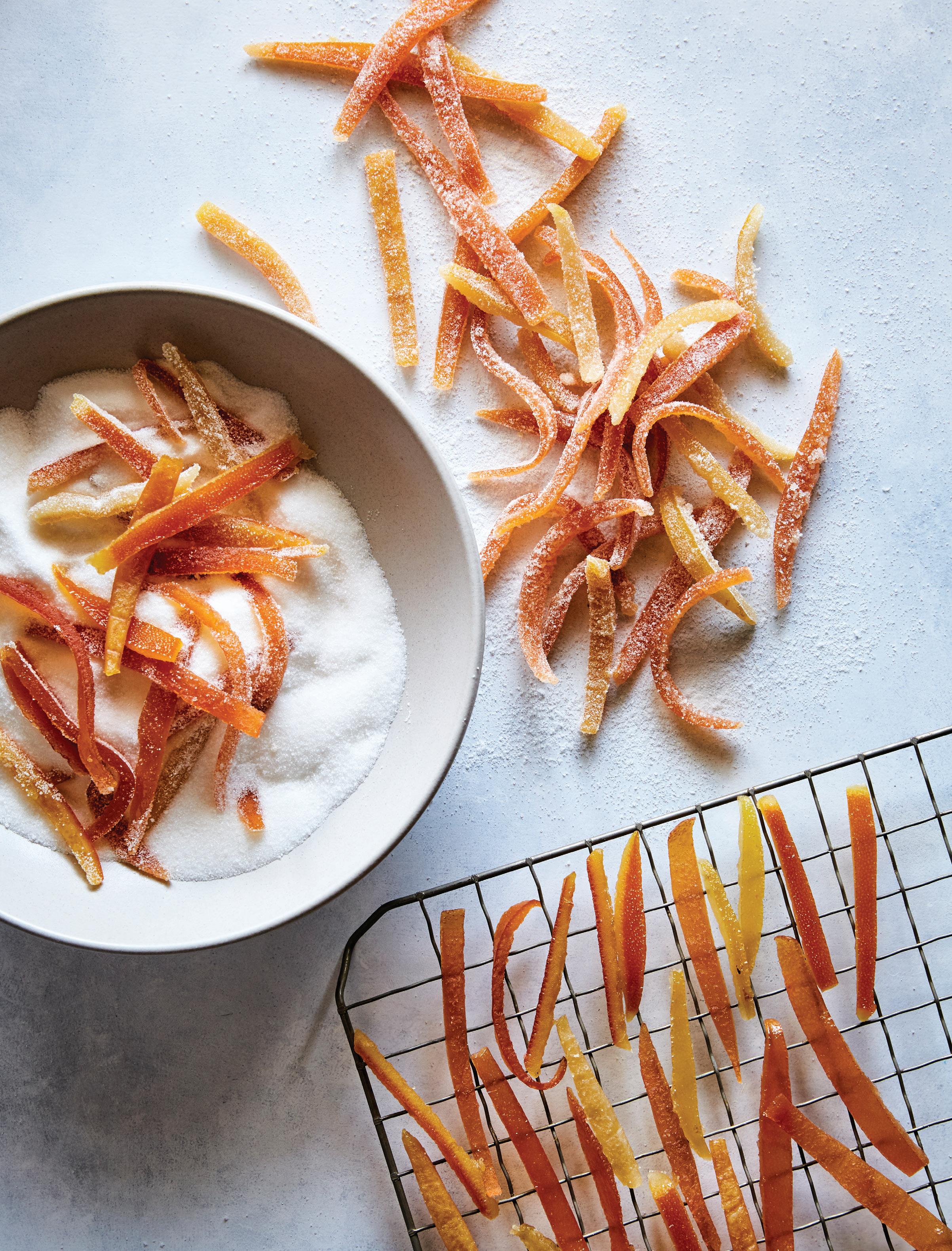
12 minute read
A More Perfect Pickle
QUICK PICKLES (RECIPES PAGE 42)
It takes only vinegar, salt and spices to make summer’s bounty come alive
There are few flavors in the world that signify summer better than a fresh cucumber pickle. The tang of vinegar and the pleasing crunch somehow make a gooey cheeseburger even better. But do you ever feel let down by store-bought pickles? If you think that you could make a better one in your kitchen, you’re correct.
Now when you hear “making pickles,” you might have visions of the hot water canning process in your head. For many, canning for preservation can be too daunting. You have to sterilize the Mason jars, buy new tops, run tests for pH and stand by your stove for hours. But you don’t need to go through that whole rigamarole—there’s an easier way. A “quick pickle” is one in which you simply add vinegar and spices to your produce and let them rest in the fridge. No blanching, boiling or sterilizing required.
It’s not just cucumbers that make a fine quick pickle. Nearly every sturdy, fibrous vegetable you’ll find overflowing in the produce aisles right now can work. Red onions are a particularly versatile pickle in summer—use the Rose Water Pickled Onions recipe on tacos and tostadas, or brats and sandwiches. And it’s not just vegetables that can be pickled. The same basic process also cures meat and fish. Salmon swimming in gin, anyone? Try the gravlax recipe.
“The New Homemade Kitchen” by Joseph Shuldiner, released last year by Chronicle Books, is a tremendous resource for all your questions on pickling, preserving, canning, fermenting, infusing and all the techniques that will extend the shelf life of your fresh produce—including candied citrus peels, which are made using an age-old preservation process. These are a few of our favorites. —John Garland

Quick Pickles Master Recipe
MAKES 2 (1-PINT) JARS
Vinegar quick pickles are easy to make and the perfect way to begin exploring your inner creative pickling impulses. Use the proportions in the recipe below to create your own custom pickle, using ingredient suggestions from the FlavorBar (at right). Remember that quick pickles will become even more delicious as they sit in the refrigerator for a few days, allowing the flavors of the spices to develop and meld with whatever it is you’re pickling. Go wild!
mixed vegetables (enough to fill two 1-pint jars) mixed spices and flavorings, to taste (see Basic Pickling Spice Mix at right) 1 cup vinegar 1 to 2 teaspoons salt 1 to 3 teaspoons sweetener (optional)
1. Wash and scrub the vegetables, peeling if desired, then cut into spears, slices, or 1-to-1½ inch chunks. Divide vegetables and any spices or flavorings evenly between two prepared 1-pint Mason jars, wedging the vegetables in as closely as possible to prevent them from floating once submerged in the pickling solution. 2. To make the pickling solution, in a small saucepan over medium-high heat, combine the vinegar, salt, sweetener, if using, and 1 cup of water. Bring to a boil, stirring until the salt and any sweeteners are dissolved, about 1 minute. Remove from the heat and carefully pour the solution over the vegetables, dividing it evenly between the jars and leaving ½-inch of headspace. 3. Allow the liquid to cool completely before sealing the jars and storing in the refrigerator overnight, or up to 3 weeks before serving.
Basic Pickling Spice Mix
MAKES 1 CUP
If you’d like to start with our Basic Pickling Spice Mix (instead of building your own), it uses eight classic ingredients. It can be stored long-term in your pantry and used for multiple batches of pickles. Use 1 to 2 teaspoons per 1 pint jar of pickles.
6 tablespoons mustard seeds 3 tablespoons allspice 2 tablespoons dill seeds 2 tablespoons coriander seeds 1 tablespoon red pepper flakes 6 cloves 3 bay leaves, crushed 3 cinnamon sticks, broken into small pieces
In a small bowl, combine all of the ingredients and mix well. Transfer to an airtight container and store in a cool, dark place for up to 1 year.
FLAVORBAR: More Pickle Ideas
Pimm’s Cup: Cucumber + lemon peel + ginger, thinly sliced + splash of Pimm’s No. 1
The Heart of a Cauliflower:
Cauliflower hearts + celery + carrots + crushed cardamom pods + turmeric
Dilly Beans: Green beans + fresh dill + garlic + red pepper flakes + dill seed
Baby Zucchini: Baby zucchini + mustard seed + coriander seed + saffron + garlic
Amazuzuke (Cucumber Sweet Vinegar Pickles)
MAKES 4 SERVINGS
Given that they can be found in nearly every Japanese home kitchen, Dean of Fermentation Yoko Maeda Lamn urged us to include at least one sunomono (Japanese vinegar pickle) recipe in the book. (In Japan, tsukemono vs. sunomono is the analogue of fermented vs. vinegar pickles in the West.) Ready in just a few hours, this Japanese quick pickle can be made right before you start dinner, or, for that matter, whenever the impulse strikes. Eat them right away or wait awhile; the longer you pickle them, the tastier they become. Oishii, ne! (“Mmmm!”)
fine sea salt 4 Japanese or 6 Persian cucumbers, ends trimmed ¼ cup rice vinegar ¼ cup raw cane sugar 1 tablespoon toasted sesame oil ½ teaspoon red pepper flakes 1. Rub a pinch of salt on the cut ends of the cucumbers and massage gently. The salt will draw out the bitter compounds and should create a bit of froth. 2. Sprinkle another healthy pinch of salt over each cucumber and rub vigorously with your hands to massage the salt into the skin. 3. Slice the cucumbers diagonally crosswise into 3⁄4-inch thick pieces and set aside. 4. In a medium bowl, combine the vinegar, sugar, sesame oil and pepper flakes. Add the cucumbers to the bowl and toss to coat the pieces well. Cover and refrigerate for 1 to 2 hours. 5. Serve immediately or transfer to an airtight container and store in the refrigerator for up to 3 days.

CANDIED CITRUS PEELS

Candied Citrus Peels
MAKES ABOUT 2 CUPS
Made using techniques that are literally hundreds of years old, sugared citrus peels continue to be an important part of many European and Middle Eastern recipes. Served as a dessert item or as a counterpoint to meat dishes, candied citrus peels allow the fruit to do double duty, providing a use for the peels that are so often discarded. We use them to decorate cakes, tarts and cookies, and as garnishes in cocktails. Wrap them up in tissue paper and place in a decorative box for a seasonally appropriate holiday gift or to score big with your host or hostess.
6 to 8 citrus fruits, such as lemons, oranges or grapefruits 3 cups granulated sugar, plus more for coating
1. With a sharp paring knife, score 4 to 6 straight lines along the sides of each citrus fruit from the stem to the bottom, cutting only through the peel and leaving the flesh inside intact. With your fingers or using a paring knife, gently pull the peel away, reserving the flesh for another use. 2. Slice each peel segment lengthwise into 1⁄4-inch strips. Leave the white pith on lemon and orange peels, but if using grapefruit, trim away and discard any spongy, excess white pith with a paring knife. 3. Place the peels in a medium saucepan with cold water to cover by 1 inch. Bring to a rolling boil over medium-high heat, then remove from the heat and drain. Repeat this process two more times with fresh water to remove the bitterness from the pith, then set the strips aside. 4. In the same saucepan over medium-high heat, bring the sugar and 3 cups of water to a boil, stirring occasionally just until the sugar dissolves. Add the citrus strips to the boiling syrup, lower the heat to medium-low and simmer gently without stirring until the strips are translucent, about 1 hour. 5. Remove from the heat and allow the strips to cool completely in the syrup. 6. Using a slotted spoon, transfer the strips to a wire cooling rack placed over a rimmed baking sheet. Spread the strips out in a single layer and allow them to drain and dry for 12 to 24 hours, until slightly sticky but no longer dripping with syrup. 7. Fill a small bowl with sugar and roll the strips around to coat. Spread the sugar-coated strips in a single layer on a wire cooling rack or on a baking sheet lined with parchment paper and allow them to dry for at least 1 hour or overnight. Transfer to an airtight container and store at room temperature for up to 2 months. Cook’s Note: Zero-waste alert! Save the leftover simple syrup from boiling the citrus strips and use it for citrusinfused cocktails. Allow to cool completely, then transfer to a clean glass jar and store, tightly sealed, in the refrigerator for up to 1 month.

Rose Water Pickled Onions
MAKES 1 PINT
Pickling onions in rose water transfigures them, lending their usual savory quality an appealing floral note. Juniper berries and star anise add to the exotic atmosphere, and the acidity of this quick pickle makes it the perfect foil to rich or unctuous dishes like pot roast, or a brightener for your favorite grain bowl.
1 medium red onion, halved and thinly sliced ½ cup rice or white wine vinegar 2 teaspoons granulated sugar 1 teaspoon kosher salt 6 juniper berries 6 black or pink peppercorns 1 star anise pod 1½ teaspoons rose water
1. Pack the onion slices into a 1 pint Mason jar and set aside. 2. In a small saucepan over medium heat, combine the vinegar, sugar, salt, spices and 1⁄2 cup of water. Bring to a boil, stirring until the sugar and salt dissolve, then immediately remove from the heat and pour the mixture over the onions. 3. Add the rose water, then set aside for at least 30 minutes, allowing the liquid to come to room temperature. Pickled onions may be used immediately but will become pinker with additional time. They taste best within the first week but may be stored in an airtight container in the refrigerator for up to 1 month.
Gravlax
MAKES 2 POUNDS
The Scandinavians have a way with preserved fish, and there’s nothing as elegant and easy to prepare as gravlax, which is similar to lox, but without the additional step of smoking. Fresh salmon is flavored with dill fronds and spices, and treated to a salt- and-sugar cure, which draws out some of the fish’s moisture, giving it a firm and velvety texture. We’ve also included a generous pour of juniper-forward gin in place of the traditional caraway-flavored Aquavit liquor. Gravlax is a showstopper, perfect for making a splash at a weekend brunch. It calls out to be thinly sliced and served open face on a slice of whole-grain bread or an “everything” bagel. Gravlax will benefit even further from sliced radishes, a dab of crème fraîche and a Gin and Tonic. We said brunch, didn’t we?
2 teaspoons coriander seeds 1 teaspoon black peppercorns 1 teaspoon yellow mustard seeds 1 teaspoon fennel seeds ½ teaspoon celery seeds ½ teaspoon red pepper flakes 3 tablespoons kosher salt 1 tablespoon granulated sugar ¼ cup gin 1 teaspoon lemon zest 1 (2-pound) salmon fillet, preferably a 1-inch-thick center cut 1 bunch fresh dill, plus more for garnish crème fraîche, for garnish (optional)
1. Coarsely crush the coriander seeds, peppercorns, mustard seeds, fennel seeds, celery seeds and red pepper flakes in a spice grinder (or crush with a mortar and pestle), then transfer to a small bowl and add the salt, sugar, gin and lemon zest, stirring to combine. 2. Cut the salmon in half against the grain and place the pieces on one large sheet of plastic wrap, skin-side down. Spread the spice mixture over the surface of both halves, lightly massaging it in. 3. Spread the dill sprigs evenly on top of one salmon half, then sandwich the second half on top, skin-side up. 4. Wrap the salmon tightly in two layers of plastic wrap and place on a rimmed tray or pan to collect any drips. 5. Place a second small tray, pan or cutting board on top of the salmon, weighting it down with a heavy can or other weight, and place in the refrigerator overnight. 6. The next day, remove the fish and the weight from the refrigerator, keeping the plastic wrap tightly sealed, and drain any liquid that has accumulated on the tray. Flip the fish over, replacing the weight, and return to the refrigerator. Repeat once a day for 2 more days. 7. After 3 days, remove the weight and discard the plastic wrap. Gently scrape off the dill and spices from the surface of both fillets and discard. 8. To serve, use a long, very sharp knife to slice each fillet as thinly as possible, cutting against the grain and on the diagonal for the greatest surface area, and leaving the skin behind. 9. Serve gravlax immediately, garnished with fresh sprigs of dill and/or a dollop of crème fraîche, if you feel like being fancy. Leftovers can be transferred to an airtight container and stored in the refrigerator for up to 3 days.
RECIPES AND PHOTOS FROM “THE NEW HOMEMADE KITCHEN” BY JOSEPH SHULDINER © 2020 REPRINTED WITH PERMISSION FROM CHRONICLE BOOKS. PHOTOGRAPHS BY REN FULLER.
QUICK PICKLES MASTER RECIPE:
PER PINT JAR: CALORIES 110; FAT 1g (sat. 0g); CHOL 0mg; SODIUM 875mg; CARB 16g; FIBER 6g; SUGAR 2g; PROTEIN 7g
AMAZUZUKE:
PER SERVING: CALORIES 100; FAT 4g (sat. 1g); CHOL 0mg; SODIUM 420mg; CARB 16g; FIBER 0g; SUGAR 13g; PROTEIN 1g
CANDIED CITRUS PEELS:
PER 2-TBSP. SERVING: CALORIES 160; FAT 0g (sat. 0g); CHOL 0mg; SODIUM 0mg; CARB 42g; FIBER 2g; SUGAR 38g; PROTEIN 0g
ROSE WATER PICKLED ONIONS:
PER PINT JAR: CALORIES 140; FAT 0g (sat. 0g); CHOL 0mg; SODIUM 2370mg; CARB 20g; FIBER 2g; SUGAR 14g; PROTEIN 1g
GRAVLAX:
PER 2- TO 3-OUNCE SERVING: CALORIES 120; FAT 4g (sat. 1g); CHOL 40mg; SODIUM 990mg; CARB 2g; FIBER 1g; SUGAR 1g; PROTEIN 17g
GRAVLAX











